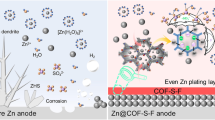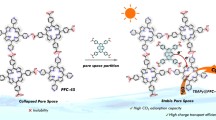Abstract
Nuclear energy holds the chief portion of the global primary energy mix that comes with the major issue of releasing volatile nuclear wastes viz. radioiodine (129I and 131I) into air and water bodies during nuclear fuel reprocessing. The efficient capture of volatile radioiodine has attracted a major attention worldwide due to the severe health and environment effects. Among various porous materials, covalent organic frameworks (COFs) are the intriguing class of porous organic materials with crystallinity, synthetically pre-designable functionalities to achieve tunable properties. Herein, a new benzothiazole based COF (COF-3) obtained by the condensation of 2,6-dimainobenzothiazole and 2,4,6-triformylpholoroglucinol is reported with tetragonal pore topology (pore volume = 0.305 cc g−1; BET surface area = 57.9 m2 g−1). The electron rich heteroatoms in the frameworks play a crucial role in adsorbing electron deficient iodine molecules and therefore, the benzothiazole-derived COF is envisioned to be potent material for efficient iodine adsorption. The synthesized COF showed the iodine adsorption capacity of 1.07 g g−1 in vapor phase and 109.0 mg g−1 from n-hexane solution. A reference COF (COF-4) with no thiazole group derived from 1,4-phenylenediamine and 2,4,6-triformylpholoroglucinol with hexagonal pore topology (pore volume = 0.937 cc g−1) and BET surface area 133.9 m2 g−1 showed adsorption of iodine from n-hexane solution with capacity 149.5 mg g−1. The study revealed that although the presence of heteroatoms in the framework facilitates the iodine adsorption by converting the molecular iodine into the polyiodides; the factors such as BET surface area, pore topology and pore volume also play a major role in the adsorption of iodine molecules.
Graphical Abstract


















Similar content being viewed by others
Data Availability
The data that supports the findings of this study are available on request from the corresponding author.
References
British Petroleum Statistical Review of World Energy (2021), 70th Ed
British Petroleum Statistical Review of World Energy (2022), 71st Ed
K. Vellingiri, K. H. Kim, A. Pournara, and A. Deep (2018). Prog. Mater. Sci. 94, 1–67. https://doi.org/10.1016/j.pmatsci.2018.01.002.
Z. J. Yan, Y. Yuan, Y. Y. Tian, D. Zhang, and G. S. Zhu (2015). Angew. Chem. Int. Ed. 54, 12733–12737. https://doi.org/10.1002/anie.201503362.
Y. Li, Y. Li, Q. Zhao, L. Li, R. Chen, and C. He (2019). Cellulose 27, 1517–1529. https://doi.org/10.1007/s10570-019-02877-0.
S. Xu, S. P. Freeman, X. Hou, A. Watanabe, K. Yamaguchi, and L. Zhang (2013). Environ. Sci. Technol. 47, 10851–10859. https://doi.org/10.1021/es401527q.
S. U. Nandanwar, K. Coldsnow, V. Utgikar, P. Sabharwall, and D. E. Aston (2016). Chem. Eng. J. 306, 369–381. https://doi.org/10.1016/j.cej.2016.07.073.
K. Munakata, S. Kanjo, S. Yamatsuki, A. Koga, and D. Ianovski (2003). J. Nucl. Sci. Technol. 40, 695–697.
K. W. Chapman, P. J. Chupas, and T. M. Nenoff (2010). J. Am. Chem. Soc. 132, 8897–8899. https://doi.org/10.1021/ja103110y.
B. J. Riley, J. D. Vienna, D. M. Strachan, J. S. McCloy, and J. L. Jerden Jr. (2016). J. Nucl. Mater. 470, 307–326. https://doi.org/10.1016/j.jnucmat.2015.11.038.
T. H. Niu, C. C. Feng, C. Yao, W. Y. Yang, and Y. H. Xu (2020). ACS Appl. Polym. Mater. 3, 354–361. https://doi.org/10.1021/acsapm.0c01136.
M. Xu, T. Wang, L. Zhou, and D. Hua (2020). J. Mater. Chem. A 8, 1966–1974. https://doi.org/10.1039/C9TA11446G.
L. He, L. Chen, X. Dong, S. Zhang, M. Zhang, X. Dai, X. Liu, P. Lin, K. Li, C. Chen, T. Pan, F. Ma, J. Chen, M. Yuan, Y. Zhang, L. Chen, R. Zhou, Y. Han, Z. Chai, and S. Wang (2021). Chem. 7, 699–714. https://doi.org/10.1016/j.chempr.2020.11.024.
P. Wang, Q. Xu, Z. Li, W. Jiang, Q. Jiang, and D. Jiang (2018). Adv. Mater. 30, 1801991. https://doi.org/10.1002/adma.201801991.
X. Jiang, X. Cui, A. J. E. Duncan, L. Li, R. P. Hughes, R. J. Staples, E. V. Alexandrov, D. M. Proserpio, Y. Wu, and C. Ke (2019). J. Am. Chem. Soc. 141, 10915–10923. https://doi.org/10.1021/jacs.9b05232.
T. Geng, Z. Zhu, X. Wang, H. Xia, Y. Wang, and D. Li (2018). Sens. Actuators B Chem. 265, 85–91. https://doi.org/10.1016/j.snb.2017.01.005.
Y. Xie, T. Pan, Q. Lei, C. Chen, X. Dong, Y. Yuan, J. Shen, Y. Cai, C. Zhou, I. Pinnau, and Y. Han (2021). Angew. Chem. Int. Ed. 60, 22432–22440. https://doi.org/10.1002/anie.202108522.
M. Wilkinson, A. Mondino, and A. Manzini (2003). J. Radioanal. Nucl. Chem. 256, 413–415. https://doi.org/10.1023/A:1024583212400.
B. J. Riley, S. Chong, M. J. Olszta, and J. A. Peterson (2020). ACS Appl. Mater. Interfaces. 12, 19682–19692. https://doi.org/10.1021/acsami.0c03155.
B. J. Riley, J. Chun, W. Um, W. C. Lepry, J. Matyas, M. J. Olszta, and X. Li (2013). Environ. Sci. Technol. 47, 7540–7547. https://doi.org/10.1021/es400595z.
B. J. Riley, D. A. Pierce, J. Chun, J. Matyáš, W. C. Lepry, T. G. Garn, J. D. Law, and M. G. Kanatzidis (2014). Environ. Sci. Technol. 48, 5832–5839. https://doi.org/10.1021/es405807w.
S. Tang, S. Choi, Y. Nan, and L. L. Tavlarides (2021). AIChE J. 67, e17137. https://doi.org/10.1002/aic.17137.
M. Janeta, W. Bury, and S. Szafert (2018). ACS Appl. Mater. Interfaces. 10, 19964–19973. https://doi.org/10.1021/acsami.8b03023.
S. Park, H. An, M. B. Park, and J. Lee (2020). Microporous Mesoporous Mater. 294, 109842–109847. https://doi.org/10.1016/j.micromeso.2019.109842.
R. Liu, W. Zhang, Y. T. Chen, Y. R. Fan, G. Z. Hu, C. Xu, and Z. Han (2020). J. Inorg. Mater. 35, 345–351. https://doi.org/10.15541/jim20190351.
J. T. Hughes, D. F. Sava, T. M. Nenoff, and A. Navrotsky (2013). J. Am. Chem. Soc. 135, 16256–16259. https://doi.org/10.1021/ja406081r.
Q. Yu, X. H. Jiang, Z. J. Cheng, Y. W. Liao, and M. Duan (2021). RSC Adv. 11, 30259–30269. https://doi.org/10.1039/d1ra05223c.
V. V. Butova, V. A. Polyakov, E. A. Erofeeva, I. S. Yahia, H. Y. Zahran, A. F. Abd El-Rehim, A. M. Aboraia, and A. V. Soldatov (2020). Inorg. Chim. Acta 509, 119678. https://doi.org/10.1016/j.ica.2020.119678.
Y. R. Lee, X. H. Do, K. Y. Cho, K. Jeong, and K. Y. Baek (2020). ACS Appl. Nano Mater. 3, 9852–9861. https://doi.org/10.1021/acsanm.0c01914.
B. Valizadeh, T. N. Nguyen, B. Smit, and K. C. Stylianou (2018). Adv. Funct. Mater. 28, 1801596. https://doi.org/10.1002/adfm.201801596.
D. Banerjee, X. Chen, S. S. Lobanov, A. M. Plonka, X. Chan, J. A. Daly, T. Kim, P. K. Thallapally, and J. B. Parise (2018). ACS Appl. Mater. Interfaces. 10, 10622–10626. https://doi.org/10.1021/acsami.8b02651.
R. Jaryal, R. Kumar, and S. Khullar (2022). Coord. Chem. Rev. 464, 214542. https://doi.org/10.1016/j.ccr.2022.214542.
M. Chebbi, B. Azambre, C. Volkringer, and T. Loiseau (2018). Microporous Mesoporous Mater. 259, 244–254. https://doi.org/10.1016/j.micromeso.2017.10.018.
K. W. Chapman, D. F. Sava, G. J. Halder, P. J. Chupas, and T. M. Nenoff (2011). J. Am. Chem. Soc. 133, 18583–18585. https://doi.org/10.1021/ja2085096.
T. D. Bennett, P. J. Saines, D. A. Keen, J. C. Tan, and A. K. Cheetham (2013). Chem. Eur. J. 19, 7049–7055. https://doi.org/10.1002/chem.201300216.
L. J. Small, R. C. Hill, J. L. Krumhansl, M. E. Schindelholz, Z. H. Y. Chen, K. W. Chapman, X. R. Zhang, S. H. Yang, M. Schroder, and T. M. Nenoff (2019). ACS Appl. Mater. Interfaces. 11, 27982–27988. https://doi.org/10.1021/acsami.9b09938.
K. Geng, T. He, R. Liu, S. Dalapati, K. Tian Tan, Z. Li, S. Tao, Y. Gong, Q. Jiang, and D. Jiang (2020). Chem. Soc. Rev. 120, 8814–8933. https://doi.org/10.1039/C2CS35157A.
A. P. Côté, A. I. Benin, N. W. Ockwig, M. O’Keeffe, A. J. Matzger, and O. M. Yaghi (2005). Science 310, 1166–1170. https://doi.org/10.1126/science.1120411.
T. F. Machado, M. Elisa, S. Serra, D. Murtinho, A. J. M. Valente, and M. Naushad (2021). Polymers 13, 970. https://doi.org/10.3390/polym13060970.
X. Feng, X. Ding, and D. Jiang (2012). Chem. Soc. Rev. 41, 6010–6022. https://doi.org/10.1039/C2CS35157A.
R. Jaryal, S. Khullar, and R. Kumar (2022). Mater. Today: Proc. 78, 885–890. https://doi.org/10.1016/j.matpr.2022.12.093.
S. Y. Ding and W. Wang (2013). Chem. Soc. Rev. 42, 548–568. https://doi.org/10.1039/C2CS35072F.
J. Xiao, J. Chen, J. Liu, H. Ihara, and H. Qiu (2022). Green Energy Environ. https://doi.org/10.1016/j.gee.2022.05.003.
R. Jaryal, R. Kumar, and S. Khullar, Metal- and carbon-based nano-frameworks as catalysts for supercapacitance and fuel industry, in U. Shanker, C. M. Hussain, and M. Rani (eds.), Handbook of green and sustainable nanotechnology: fundamentals, developments and applications (Springer, Cham, 2023).
N. Huang, P. Wang, and D. Jiang (2016). Nat. Rev. Mater. 1, 16068. https://doi.org/10.1038/natrevmats.2016.68.
Z. J. Yin, S. Q. Xu, T. G. Zhan, Q. Y. Qi, Z. Q. Wu, and X. Zhao (2017). Chem. Comm. 53, 7266–7269. https://doi.org/10.1039/C7CC01045A.
Y. Yang, C. Tu, H. Yin, J. Liu, F. Cheng, and F. Luo (2022). Molecules. 27, 9045. https://doi.org/10.3390/molecules27249045.
X. Guo, Y. Li, M. Zhang, K. Cao, Y. Tian, Y. Qi, S. Li, K. Li, X. Yu, and L. Ma (2020). Angew. Chem. Int. Ed. 132, 22886–22894. https://doi.org/10.1002/anie.202010829.
C. Wang, Y. Wang, R. L. Ge, X. D. Song, X. Q. Xing, Q. K. Jiang, H. Lu, C. Hao, X. W. Guo, Y. A. Gao, and D. L. Jiang (2018). Chem. Eur. J. 24, 585–589. https://doi.org/10.1002/chem.201705405.
Y. B. Zhang, L. M. Li, M. G. Wang, and Z. Y. Duan (2021). Heterocycles 102, 1395–1401. https://doi.org/10.3987/COM-21-14463.
J. H. Zhang, J. C. Liu, Y. Z. Liu, Y. J. Wang, Q. R. Fang, and S. L. Qiu (2022). Chem. Res. Chin. Univ. 38, 456–460. https://doi.org/10.1007/s40242-022-1513-3.
G. J. Xu, J. H. Chang, and Q. R. Fang (2020). Chem. J. Chin. Univ. 41, 2667–2672. https://doi.org/10.7503/cjcu20200624.
Y. Li, X. G. Li, J. F. Li, W. Liu, G. E. Cheng, and H. Z. Ke (2021). Microporous Mesoporous Mater. 325, 111351. https://doi.org/10.1016/j.micromeso.2021.111351.
Z. L. Wen, S. L. Wang, S. Y. Fu, J. Y. Qian, Q. Q. Yan, H. J. Xu, K. M. Zuo, X. F. Su, C. Y. Zeng, and Y. A. Gao (2022). Chem. Res. Chin. Univ. 38, 472–477. https://doi.org/10.1007/s40242-022-2057-2.
R. Chen, T. L. Hu, W. Zhang, C. Y. He, and Y. Q. Li (2021). Microporous Mesoporous Mater. 312, 110739. https://doi.org/10.1016/j.micromeso.2020.110739.
S. Song, Y. Shi, N. Liu, and F. Liu (2021). RSC Adv. 11, 10512–10523. https://doi.org/10.1039/D0RA10587B.
Y. Yang, X. Xiong, Y. Fan, Z. Lai, Z. Xu, and F. Luo (2019). J. Solid State Chem. 279, 120979. https://doi.org/10.1016/j.jssc.2019.120979.
S. Kandambeth, A. Mallick, B. Lukose, M. V. Mane, T. Heine, and R. Banerjee (2012). J. Am. Chem. Soc. 134, 19524–19527. https://doi.org/10.1021/ja308278w.
C. R. DeBlase, K. E. Silberstein, T.-T. Truong, H. D. Abrun, and W. R. Dichtel (2013). J. Am. Chem. Soc. 135, 16821–16824. https://doi.org/10.1021/ja409421d.
S. H. M. Mehr, B. O. Patrick, and M. J. MacLachlan (2016). Org. Lett. 18, 1840–1843. https://doi.org/10.1021/acs.orglett.6b00577.
Acknowledgments
Ms. Ritika Jaryal is thankful to Ministry of Education for providing fellowship assistantship. Authors are thankful to Dr. Hitesh Sharma (PTU Jalandhar, India) for his help with Material Studio Suite for simulations and modeling.
Funding
RJ thanks Ministry of Education, Govt. of India for the research scholarship. Funds for this research were provided by Dr B R Ambedkar National Institute of Technology Jalandhar. No other external funding was available for this research work.
Author information
Authors and Affiliations
Contributions
SK and RK designed and conceptualized the research work. RJ carried out the experimental work and characterization of materials. All the authors compiled and finalized the manuscript.
Corresponding authors
Ethics declarations
Conflict of interest
The authors declare that they have no known competing financial interests.
Ethical Approval
Not applicable.
Additional information
Publisher's Note
Springer Nature remains neutral with regard to jurisdictional claims in published maps and institutional affiliations.
Supplementary Information
Below is the link to the electronic supplementary material.
10876_2023_2495_MOESM1_ESM.docx
Supplementary material is available at the journal’s website. Supplementary Information contains the 1H-NMR spectra of the synthesized monomers (Figs. S1–S3), Schematic procedure for the synthesis of COF (Scheme S1), Elemental analysis of COF-3 and COF-4 (Table S1),13C CP-MAS solid-state NMR spectra of COFs (Figs. S4, S5), HR-TEM images of COFs (Fig. S6), TGA scans of COFs (Fig. S7), IR Spectra of COF-3 and COF-4 after acid (1N HCl) and base (1N NaOH) treatment (Figs. S8, S9), PXRD of COF-3 and COF-4 after acid (1N HCl) and base (1N NaOH) treatment (S10), XPS spectra of COFs (Fig. S11). Reported COFs for iodine adsorption in vapor and/or solution phase (Table S2), References. Supplementary file1 (DOCX 2365 KB)
Rights and permissions
Springer Nature or its licensor (e.g. a society or other partner) holds exclusive rights to this article under a publishing agreement with the author(s) or other rightsholder(s); author self-archiving of the accepted manuscript version of this article is solely governed by the terms of such publishing agreement and applicable law.
About this article
Cite this article
Jaryal, R., Khullar, S. & Kumar, R. Benzothiazole-Derived Covalent Organic Framework for Multimedia Iodine Uptake. J Clust Sci 35, 461–479 (2024). https://doi.org/10.1007/s10876-023-02495-8
Received:
Accepted:
Published:
Issue Date:
DOI: https://doi.org/10.1007/s10876-023-02495-8




